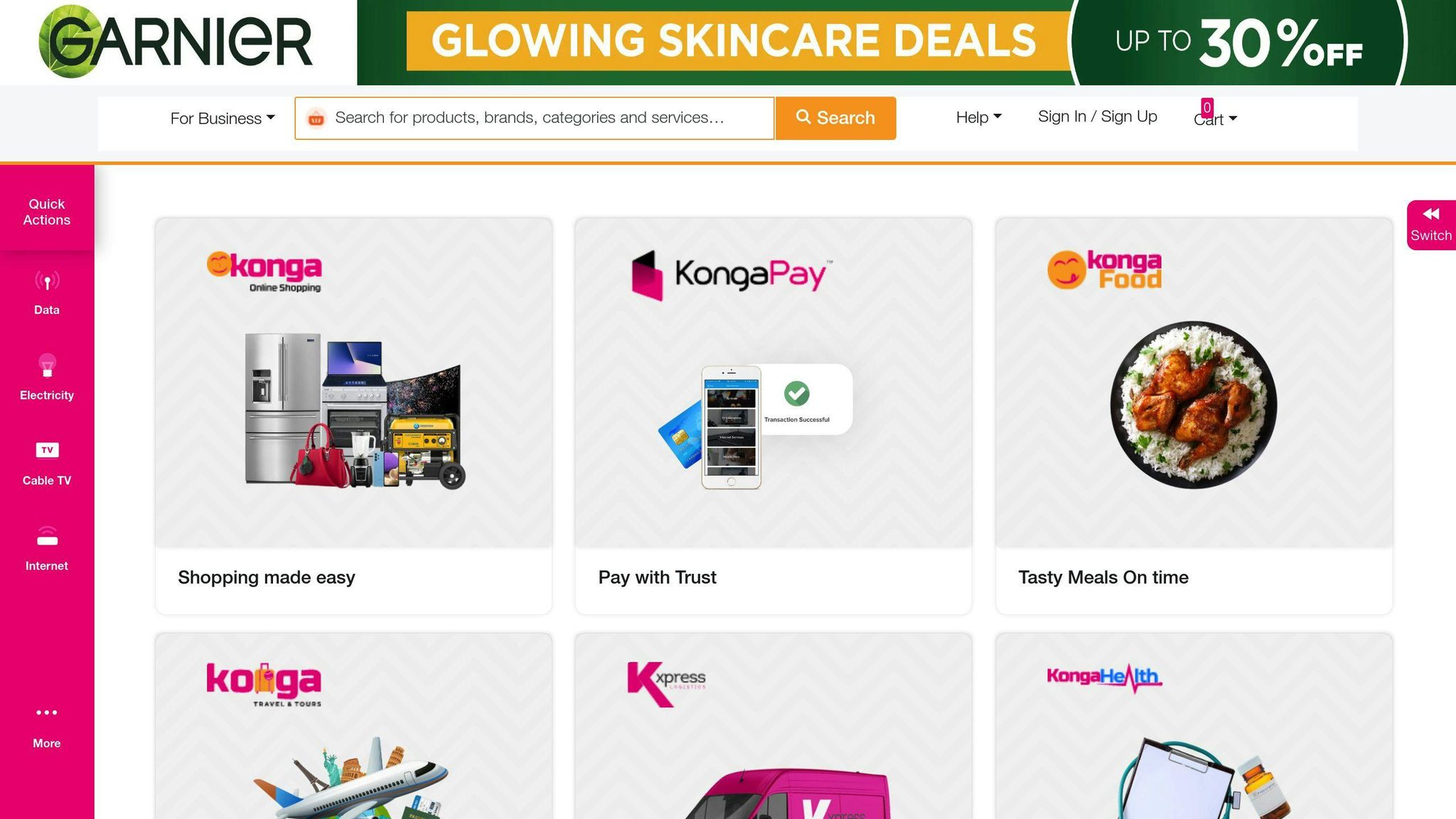Africa’s e-commerce market is growing fast, projected to reach $46.1 billion by 2025 and $113 billion by 2029, with over 518 million users expected by 2025. Mobile commerce, financial innovations, and the African Continental Free Trade Area (AfCFTA) are driving this growth.
Quick Highlights:
- Market Growth: From $7.7 billion in 2017 to $46.1 billion in 2025 (24.7% annual growth).
- Mobile Commerce: 60% of transactions by 2025.
- Financial Inclusion: Tools like JumiaPay and KongaPay bridge gaps for the unbanked.
- Top Regions: Nigeria, Kenya, South Africa, and Egypt lead due to better digital infrastructure and urbanization.
Key Platforms:
- Jumia: Strong logistics and local partnerships.
- Konga: Flexible payments and efficient inventory.
- Takealot: Fast delivery and eco-friendly practices.
Despite challenges like limited banking access and infrastructure gaps, Africa’s young, tech-savvy population and advancing payment solutions are reshaping the market. Businesses must focus on mobile-first strategies, logistics, and cross-border opportunities to thrive.
Market Overview: Growth and Drivers
Market Size and Growth Forecast
Africa’s e-commerce sector is seeing rapid growth, with market valuations skyrocketing. Starting at $7.7 billion in 2017, the market is expected to hit $46.1 billion by 2025, growing at an annual rate of 24.7%. This marks a staggering 500% increase in just seven years.
Here’s a closer look at the revenue trends:
| Year | Revenue (USD) | Growth Rate |
|---|---|---|
| 2021 | $28 billion | 31% |
| 2022 | $33.3 billion | 19% |
| 2023 | $38.2 billion | 14.7% |
| 2025 | $46.1 billion | 9% |
However, this growth isn’t evenly spread, with certain regions leading the way.
Leading E-commerce Regions
Four major markets are driving Africa’s e-commerce boom. These regions stand out due to:
- Well-developed digital payment systems
- High internet usage
- Expanding urban populations
- Widespread mobile device adoption
- Varying levels of financial inclusion:
- Kenya: 88% bank account access
- South Africa: 82% bank account access
- Nigeria: 51% bank account access
- Egypt: 38% bank account access
These highlights show how digital infrastructure and financial access fuel e-commerce in Africa. Broader trends in technology and demographics further support this growth.
Factors Driving Growth
Several key factors are pushing the e-commerce surge in Africa:
- Digital Adoption and Youth Demographics: A young, tech-savvy population is embracing digital platforms, with e-commerce users projected to reach 518 million by 2025.
- Mobile Commerce: By 2025, mobile devices are expected to account for 60% of all e-commerce transactions.
- Financial Innovation: New embedded finance solutions are making transactions easier and safer.
- Cross-Border Trade: The AfCFTA is helping unify Africa’s digital marketplace, fostering more cross-border e-commerce.
Trends Shaping African E-commerce
Mobile-Driven Economy
In 2021, mobile devices accounted for 69% of web traffic, and this trend has only grown stronger. By 2025, it’s estimated that mobile devices will handle 60% of all e-commerce transactions. This shift has pushed e-commerce platforms to prioritize mobile-first strategies.
Platforms like Takealot in South Africa have upgraded their mobile experiences with features like one-click purchasing and streamlined checkout processes. As mobile usage continues to rise, new payment methods tailored to Africa’s diverse consumer needs are becoming increasingly important.
Embedded Finance Growth
Embedded finance solutions are changing how people shop online in Africa. Services like digital wallets and buy-now-pay-later options are helping to bridge the gap for underbanked communities.
Here are some examples of how embedded finance is making an impact:
| Solution | Market Impact |
|---|---|
| JumiaPay | Reaches unbanked users in 11 countries |
| KongaPay | Simplifies payments in Nigeria |
| Takealot Payment Options | Improves accessibility for South African shoppers |
While these solutions address payment hurdles, the African Continental Free Trade Area (AfCFTA) is working on removing barriers to cross-border trade, aiming to create a seamless e-commerce environment.
AfCFTA‘s Role in E-commerce
The AfCFTA agreement is reshaping cross-border e-commerce with several initiatives:
- Simplified Customs: Faster and cheaper deliveries through streamlined processes
- Unified Market: A single trading space for participating countries
- Lower Barriers: Reduced tariffs make cross-border transactions more appealing
Successful Platforms and Business Models
Jumia: Expanding Across Africa

Jumia has become a leader in Africa’s e-commerce scene by building a strong logistics network across 11 countries and forming local partnerships to offer a wide variety of products. By tailoring its approach to meet local market demands, Jumia has created a platform that acts as a one-stop shop for its customers. Its use of data to fine-tune inventory ensures that products are always available when and where they’re needed.
Konga: Simplifying Payments

Konga has reshaped Nigeria’s e-commerce market by offering flexible payment options such as credit cards, debit cards, and mobile money services. This makes online shopping more accessible to a broader audience. Alongside this, Konga uses advanced data analytics to streamline inventory management and ensure customer needs are met efficiently, all while maintaining strong logistics capabilities.
Takealot: Leading in South Africa
Takealot dominates South Africa’s e-commerce space with fast delivery in urban areas, an extensive product catalog, and eco-conscious practices like sustainable packaging and energy-efficient warehouses. Collaborations with global brands have allowed Takealot to expand its offerings while staying relevant to local consumers. Its focus on infrastructure and customer service has set a high bar for e-commerce in the region.
These platforms are successfully navigating Africa’s unique e-commerce challenges by tapping into local trends and needs. Their innovative strategies highlight how businesses can overcome obstacles while unlocking new opportunities in this growing market.
sbb-itb-dd089af
E-commerce Opportunities and Challenges
Cross-Border E-commerce
The implementation of AfCFTA is opening up new possibilities for cross-border e-commerce. Platforms like Jumia are benefiting from reduced tariffs and improved logistics, allowing them to expand their reach. However, businesses still face hurdles like regulatory complexities and infrastructure gaps. To thrive in this unified market, companies need strategic partnerships and reliable logistics systems to tackle these challenges. While cross-border trade offers growth potential, adopting eco-conscious practices is becoming equally important to meet shifting consumer expectations.
Sustainability in E-commerce
Eco-conscious practices are becoming a priority in African e-commerce. Platforms are finding ways to meet consumer demands for greener solutions while also minimizing their environmental footprint.
| Sustainable Practice | Example & Impact |
|---|---|
| Eco-friendly Packaging | Takealot uses recyclable materials to cut down on waste |
| Optimized Delivery Routes | Jumia uses advanced logistics to lower carbon emissions |
| Local Sourcing | Konga works with local suppliers to reduce transport emissions |
As these platforms push forward with greener initiatives, they must also tackle ongoing issues in payments and infrastructure to unlock the market’s full potential.
Payment and Infrastructure Issues
Nearly half of Africans remain unbanked, but innovative solutions like M-Pesa are bridging this gap. Platforms such as Paystack are also making secure and flexible payments more accessible. Tools like JumiaPay and KongaPay are expanding payment options across the continent, but challenges persist.
Key issues include:
- Digital Payment Adoption: While 69% of web traffic comes from mobile internet, payment processing still presents challenges.
- Banking Integration: Limited access to traditional banking systems means alternative solutions are essential.
- Infrastructure Reliability: Unstable power supplies and inconsistent internet connectivity disrupt service delivery.
"The rise of mobile-based payment solutions and the implementation of the AfCFTA protocol are transforming how we approach e-commerce challenges in Africa. These innovations are not just solving problems – they’re creating new opportunities for growth." – International Trade Administration
Conclusion
Key Takeaways
Africa’s e-commerce market is on track to hit $113 billion by 2029, growing at a rate of 11.9% annually between 2025 and 2029. This rapid shift is fueled by better digital infrastructure and a young, tech-savvy population. Key players like Nigeria, Kenya, South Africa, and Egypt are leading this transformation, with the number of e-commerce users expected to reach 518 million by 2025.
Here’s a snapshot of what’s driving growth in these regions:
| Region | Growth Drivers |
|---|---|
| Nigeria | Mobile commerce adoption, large youth population |
| Kenya | Digital payment innovations, urban connectivity |
| South Africa | Strong logistics systems, high internet access |
| Egypt | Expanding middle class, digital modernization |
What’s Next for African E-commerce?
The path forward for African e-commerce is being shaped by major shifts like the AfCFTA’s push for a unified market and new payment systems that address gaps in traditional banking. Both local startups and global companies are introducing models customized for African consumers.
To thrive in this space, businesses should:
- Focus on mobile-first platforms and regional preferences.
- Solve logistics and payment challenges with creative solutions.
- Use cutting-edge technologies to improve customer experiences.
With tech advancements, supportive policies, and a maturing market, African e-commerce is set for steady growth. Embedded finance is gaining ground, and cross-border trade is becoming easier, opening up new opportunities for businesses and shoppers alike.
The evolving e-commerce landscape in Africa calls for businesses to stay flexible and innovative, ensuring they contribute to – and benefit from – the region’s digital growth.
The State of E-Commerce in Africa Today
FAQs
As Africa’s e-commerce industry grows, here are answers to some key questions shaping its development.
What is the future of e-commerce in Africa?
Africa’s e-commerce market is expected to hit $113 billion by 2029, with an annual growth rate of 11.9% from 2025 to 2029. Several factors are fueling this growth:
| Factor | Impact on E-commerce |
|---|---|
| Population Growth | A larger, younger digital consumer base |
| Mobile Economy | Mobile devices to account for 60% of transactions by 2025 |
| Digital Users | 518 million e-commerce users anticipated by 2025 |
| Regional Leaders | Innovation hubs in Nigeria, Kenya, South Africa, and Egypt |
Africa’s strength in mobile commerce, combined with the AfCFTA and embedded finance tools, is setting the stage for long-term growth. By 2040, mobile commerce is expected to dominate e-commerce transactions, supported by advancements in digital infrastructure and payment systems.
How big is the eCommerce market in Africa?
The African e-commerce market is growing fast, with these key stats:
- Market Value: $277 billion in 2023
- Growth Rate: 14.4% annual growth forecast through 2032
- Top Sectors: Fashion and electronics are expected to lead sales by 2025
Key factors shaping the market include:
- Regional differences in financial inclusion, with Kenya leading at 88% bank account penetration
- AfCFTA’s role in boosting cross-border trade
- New payment solutions addressing gaps in infrastructure
However, challenges remain. Credit card ownership averages just 2% across the continent, and many people remain unbanked. These hurdles are driving the push for alternative payment methods and digital banking solutions.
These trends underline the transformative opportunities in Africa’s e-commerce space, offering a guide for businesses and investors navigating this evolving market.
Related Blog Posts
- 10 African Tech Investors to Watch in 2025
- African Tech Hub Comparison: Lagos vs Nairobi vs Cape Town
- Ride sharing and ride hailing startups in Africa
- How Digital Skills Training Boosts African Startups





